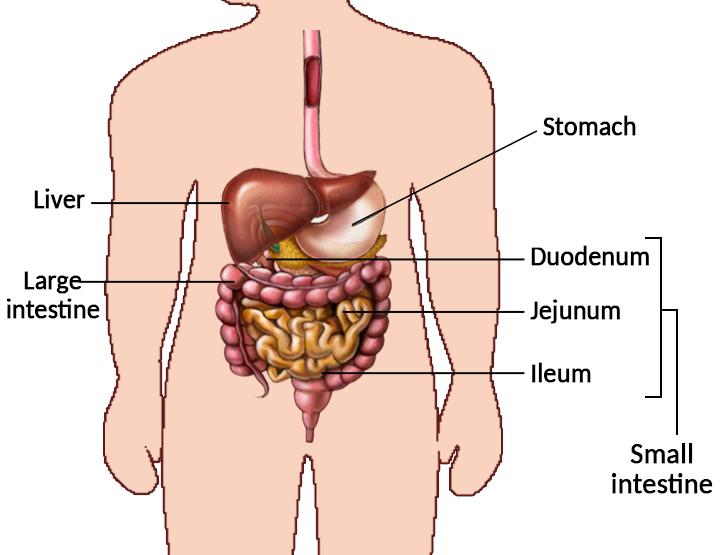
In which part of the alimentary canal, food is finally digested?
(a) Stomach
(b) Mouth cavity
(c) Large intestine
(d) Small intestine
Answer
575.7k+ views
Hint: This part of the alimentary canal is made up of three segments, the duodenum, jejunum, and ileum. This part is involved in the complete digestion and absorption of the food. Two types of movement of food occur in this part, rhythmic (regular) and peristaltic (wave-like) movement.
Complete answer:
The food is finally digested in the small intestine of the alimentary canal because it has all the enzymes needed for the digestion of every type of food. The intestine has a bile enzyme for the emulsification (break down) of fats. It has pancreatic lipase and intestinal lipase enzyme, which help in the final digestion of fats. It has pancreatic amylase for the digestion of carbohydrates. It has trypsinogen, which breaks trypsin under influence of enterokinase enzyme. Trypsin enzyme helps in the digestion of proteins. It has Erepsin, which again helps in the digestion of protein.
The small intestine is the longest part (6 meters) of the alimentary canal. It is a tubular part occupying the central and lower part of the abdominal cavity.
The small intestine is divided into the following parts:
1. Duodenum - It is the widest, shortest, and most flexed part of the small intestine. It is C-shape and receives bile from the pancreas.
2. Jejunum - It is the middle part of the small intestine.
3. Ileum - It is the longest part of the small intestine. It's finally open in the caecum in the lower part of the abdominal cavity.

So, the correct answer is, ‘Small intestine.’
Additional Information:
- Crypts of Lieberkuhn are present throughout the mucosa of the small intestine between villi (absorptive unit) . These secrete a digestive enzyme.
- Brunner’s glands are found in the submucosa of the small intestine and secrete an alkaline enzyme.
Note: The whole mucosa of the alimentary canal is lined by goblet cells. These secrete mucus which lubricates the alimentary canal and food peristalsis. The fully digested intestinal food present in the small intestine is called chyle. The semi- digested and acidic food present inside the stomach is known as chyme.
Complete answer:
The food is finally digested in the small intestine of the alimentary canal because it has all the enzymes needed for the digestion of every type of food. The intestine has a bile enzyme for the emulsification (break down) of fats. It has pancreatic lipase and intestinal lipase enzyme, which help in the final digestion of fats. It has pancreatic amylase for the digestion of carbohydrates. It has trypsinogen, which breaks trypsin under influence of enterokinase enzyme. Trypsin enzyme helps in the digestion of proteins. It has Erepsin, which again helps in the digestion of protein.
The small intestine is the longest part (6 meters) of the alimentary canal. It is a tubular part occupying the central and lower part of the abdominal cavity.
The small intestine is divided into the following parts:
1. Duodenum - It is the widest, shortest, and most flexed part of the small intestine. It is C-shape and receives bile from the pancreas.
2. Jejunum - It is the middle part of the small intestine.
3. Ileum - It is the longest part of the small intestine. It's finally open in the caecum in the lower part of the abdominal cavity.

So, the correct answer is, ‘Small intestine.’
Additional Information:
- Crypts of Lieberkuhn are present throughout the mucosa of the small intestine between villi (absorptive unit) . These secrete a digestive enzyme.
- Brunner’s glands are found in the submucosa of the small intestine and secrete an alkaline enzyme.
Note: The whole mucosa of the alimentary canal is lined by goblet cells. These secrete mucus which lubricates the alimentary canal and food peristalsis. The fully digested intestinal food present in the small intestine is called chyle. The semi- digested and acidic food present inside the stomach is known as chyme.
Recently Updated Pages
Master Class 12 Economics: Engaging Questions & Answers for Success

Master Class 12 Maths: Engaging Questions & Answers for Success

Master Class 12 Biology: Engaging Questions & Answers for Success

Master Class 12 Physics: Engaging Questions & Answers for Success

Master Class 8 Maths: Engaging Questions & Answers for Success

Class 8 Question and Answer - Your Ultimate Solutions Guide

Trending doubts
What is meant by exothermic and endothermic reactions class 11 chemistry CBSE

Which animal has three hearts class 11 biology CBSE

10 examples of friction in our daily life

One Metric ton is equal to kg A 10000 B 1000 C 100 class 11 physics CBSE

1 Quintal is equal to a 110 kg b 10 kg c 100kg d 1000 class 11 physics CBSE

Difference Between Prokaryotic Cells and Eukaryotic Cells




